Research on Solid Shell Growth during Continuous Steel Casting
Abstract
:1. Introduction
2. Modelling of the Solid Shell Growth
2.1. Modelling Methods of the Thickness of the Solid Shell
2.2. Methodology of Simulation and Model Verification
3. Results
3.1. Modelling of the Average Shell Thickness on the Real Caster
3.2. Analysis of the Shell Thickness of the Real Blank after Breakout
3.3. Verification of a Numerical Model Using the Real Shell Thickness Measurement
4. Conclusions
Author Contributions
Funding
Institutional Review Board Statement
Informed Consent Statement
Data Availability Statement
Conflicts of Interest
References
- Čada, R. Formability of deep-drawing steel sheets. In 5th European Conference on Advanced Materials and Processes and Applications (EUROMAT 97): Materials, Functionality Design; Sarton, L.A.J.L., Zeedijk, H.B., Eds.; Volume 4—Characterization and Production/Design; Netherlands Society for Materials Science: Maastricht, The Netherlands, 1997; pp. 463–466. ISBN 90-803513-4-2. [Google Scholar]
- Bratu, V.; Mortici, C.; Oros, C.; Ghiban, N. Mathematical model of solidification process in steel continuous casting taking into account the convective heat transfer at liquid–solid interface. Comput. Mater. Sci. 2014, 94, 2–7. [Google Scholar] [CrossRef]
- Yao, C.; Wang, M.; Zhang, M.; Xing, L.; Zhang, H.; Bao, Y. Effects of mold electromagnetic stirring on heat transfer, species transfer and solidification characteristics of continuous casting round billet. J. Mater. Res. Technol. 2022, 19, 1766–1776. [Google Scholar] [CrossRef]
- Trana, H.S.; Castiauxb, E.; Habrakena, A.-M. Thermal Analysis of Solidifying Steel Shell in Continuous Casting Process. Procedia Manuf. 2020, 47, 686–692. [Google Scholar] [CrossRef]
- Zhang, H.; Wang, W. Mold Simulator Study of Heat Transfer Phenomenon During the Initial Solidification in Continuous Casting Mold. Metall. Mater. Trans. B 2017, 48, 779–793. [Google Scholar] [CrossRef] [Green Version]
- Hanao, M.; Kawamoto, M.; Yamanaka, A. Growth of Solidified Shell Just below the Meniscus in Continuous Casting Mold. ISIJ Int. 2009, 49, 365–374. [Google Scholar] [CrossRef] [Green Version]
- Pyszko, R.; Franěk, Z.; Příhoda, M.; Velička, M.; Sikora, K. Monitoring and simulation of the unsteady states in continuous casting. Mater. Technol. 2018, 52, 111–117. [Google Scholar] [CrossRef]
- Miłkowska-Piszczek, K.; Falkus, J. Calculation of the boundary conditions in the continuous casting of steel process. Metallurgy 2014, 53, 571–573. [Google Scholar]
- Jeong, M.; Choi, C.; Ha, M.Y.; Kim, S.J.; Park, J.K.; Oh, K.S. Numerical simulation of continuous casting process of different steel grades considering solidification and mixing of different steel grades. Met. Mater. Int. 2015, 21, 303–310. [Google Scholar] [CrossRef]
- Velicka, M.; Dittel, D.; Pyszko, R.; Prihoda, M.; Vaculik, M.; Fojtik, P.; Burda, J. Research of thermal processes for the continuous casting of steel. Mater. Technol. 2013, 47, 815–818. [Google Scholar]
- Čada, R.; Pektor, T. Design of Stamping Drawing Technology from Thin Sheet. In Proceedings of the 31st International Conference on Metallurgy and Materials METAL 2022, Ostrava, Czech Republic, 18–19 May 2022; pp. 262–267. [Google Scholar] [CrossRef]
- Březina, M.; Mauder, T.; Klimeš, L.; Štětina, J. Comparison of optimization-regulation algorithms for secondary cooling in continuous steel casting. Metals 2021, 11, 237. [Google Scholar] [CrossRef]
- Cicutti, C.; Boeri, R. A Simple Estimation Method for Shell Thickness at the Mold Exit in the Continuous Casting of Steel. ISIJ Int. 2001, 41, 311–313. [Google Scholar] [CrossRef] [Green Version]
- Iwasaki, J.; Thomas, B.G. Thermal-mechanical model calibration with breakout shell measurements in continuous steel slab casting. Suppl. Proc. Mater. Prop. Charact. Model. 2012, 2, 355–662. [Google Scholar]
- Song, J.X.; Cai, Z.-Z.; Piao, F.-Y.; Zhu, M.-Y. Heat Transfer and Deformation Behavior of Shell Solidification in Wide and Thick Slab Continuous Casting Mold. J. Iron Steel Res. Int. 2014, 21, 1–9. [Google Scholar] [CrossRef]
- Ansari, M.O.; Ghose, J.; Chattopadhyaya, S.; Ghosh, D.; Sharma, S.; Sharma, P.; Kumar, A.; Li, C.; Singh, R.; Eldin, S.M. An Intelligent Logic-Based Mold Breakout Prediction System Algorithm for the Continuous Casting Process of Steel: A Novel Study. Micromachines 2022, 13, 2148. [Google Scholar] [CrossRef]
- Natsume, Y.; Oka, Y.; Ogawa, J.; Ohno, M. Estimation of time-dependent heat transfer coefficient in unidirectional casting using a numerical model coupled with solidification analysis and data assimilation. Int. J. Heat Mass Transf. 2020, 150, 119222. [Google Scholar] [CrossRef]
- Stieven, G.D.M.; Soares, D.D.R.; Oliveira, E.P.; Lins, E.F. Interfacial Heat Transfer Coefficient in Unidirectional Permanent Mold Casting: Modeling and Inverse Estimation. Int. J. Heat Mass Transf. 2021, 166, 120765. [Google Scholar] [CrossRef]
- Grozdanić, V. Numerical simulation of solidification of cast steel cylinder. Metallurgy 2000, 39, 285–287. [Google Scholar]
- Santos, A.C.; Spim, A.J.; Garcia, A. Mathematical modeling and optimization strategies (genetic algorithm and knowledge base) applied to the continuous casting of steel. Eng. Appl. Artif. Intell. 2003, 16, 511–527. [Google Scholar] [CrossRef]
- Wang, X.; Tang, L.; Zang, X.; Yao, M. Mold transient heat transfer behavior based on measurement and inverse analysis of slab continuous casting. J. Mater. Process. Technol. 2012, 212, 1811–1818. [Google Scholar] [CrossRef]
- Mosayebidorcheh, S.; Gorji-Bandpy, M. Local and averaged-area analysis of steel slab heat transfer and phase change in continuous casting process. Appl. Therm. Eng. 2017, 118, 724–733. [Google Scholar] [CrossRef]
- Dvorkin, N.E.; Cavaliere, A.M.; Goldschmidt, B.M. Finite element models in the steel industry Part I.: Simulation of flat product manufacturing processes. Comput. Struct. 2003, 81, 559–573. [Google Scholar] [CrossRef]
- Pascon, F.; Habraken, A. Finite element study of the effect of some local defects on the risk of transverse cracking in continuous casting of steel slabs. Comput. Methods Appl. Mech. Eng. 2007, 196, 2285–2299. [Google Scholar] [CrossRef] [Green Version]
- Poirier, D.; Salcudean, M. On numerical methods used in mathematical modelling of phase change in liquids metals’. J. Heat Transf. 2009, 110, 562–570. [Google Scholar] [CrossRef]
- Sviželová, J.; Tkadlečková, M.; Michalek, K.; Gryc, K.; Socha, L. Influence of Casting Speed on Solidification of Continuously Cast Round Steel Billets. Hut. Listy 2017, 2, 22–27. [Google Scholar]
- Miłkowska-Piszczek, K.; Dziarmagowski, M.; Buczek, A.; Pióro, J. The methods of calculating the solidifying strand shell thickness in a continuous casting machine. Arch. Mater. Sci. Eng. 2012, 57, 75–79. [Google Scholar]
- Barella, S.; Gruttadauria, A.; Mapelli, C.; Mombelli, D. Investigation of failure and damages on a continuous casting copper mould. Eng. Fail. Anal. 2014, 36, 432–438. [Google Scholar] [CrossRef]
- Aksoy, B.; Koru, M. Estimation of Casting Mold Interfacial Heat Transfer Coefficient in Pressure Die Casting Process by Artificial Intelligence Methods. Arab. J. Sci. Eng. 2020, 45, 8969–8980. [Google Scholar] [CrossRef]
- Zhang, Z.; Wu, M.; Zhang, H.; Hahn, S.; Wimmer, F.; Ludwig, A.; Kharicha, A. Modeling of the as-cast structure and macrosegregation in the continuous casting of a steel billet: Effect of M-EMS. J. Mater. Process. Technol. 2022, 301, 117434. [Google Scholar] [CrossRef]
- Schlautmann, M.; Köster, M.; Krieger, W.; Groll, M.; Schuster, R.; Bellmann, J.; Frittella, P. Measurement and Model-Based Control of Solidification in Continuous Casting of Steel Billets. Appl. Sci. 2023, 13, 885. [Google Scholar] [CrossRef]
- Liu, H.; Xu, B.; Ren, Z.; Zhu, F. Study on Solidification Shell Thickness of Continuous Casting Billet. Asp. Min. Miner. Sci. 2021, 6, 718–719. [Google Scholar] [CrossRef]
- Asif, M.; Sadiq, M.M. Inverse analysis of mould-casting interfacial heat transfer towards improved castings. Mater. Today Proc. 2022, 56, 742–748. [Google Scholar] [CrossRef]
- Bohacek, J.; Kharicha, A.; Ludwig, A.; Wu, M.; Karimi-Sibaki, E. Heat Transfer Coefficient at Cast-Mold Interface During Centrifugal Casting: Calculation of Air Gap. Metall. Mater. Trans. B 2018, 49, 1421–1433. [Google Scholar] [CrossRef] [Green Version]
- Velička, M.; Pyszko, R.; Příhoda, M.; Molínek, J. Research of heat transport in mould for continuous casting of steel. Metallurgy 2009, 48, 235–238. [Google Scholar]
- Trana, H.-S.; Castiauxb, E.; Habrakena, A.-M. 2D thermal finite element analysis of sticker breakout in continuous casting. Procedia Manuf. 2020, 50, 1421–1433. [Google Scholar] [CrossRef]
- Li, D.; Wu, H.; Wang, H.; Li, H. Growth of solidified shell in bloom continuous casting mold of hypo-peritectic steel based on a FeS tracer method. J. Iron Steel Res. Int. 2020, 27, 782–787. [Google Scholar] [CrossRef]
- Pyszko, P.; Příhoda, M.; Machů, M.; Franěk, Z. Data processing of measured surface temperatures of continuously cast billets and blooms to verify the numerical solidification model. In Proceedings of the 29th International Conference on Metallurgy and Materials METAL 2020, Ostrava, Czech Republic, 20–22 May 2020; pp. 80–85. [Google Scholar] [CrossRef]
- Tsuneoka, A.; Ohashi, W.; Ishitobi, S.; Kataoka, T.; Tenma, M. Measurement and control system of solidification in continuous casting mold. ISS Steelmak. Conf. Proc. 1985, 68, 3–10. [Google Scholar]
- Janik, M.; Dyja, H.; Berski, S.; Banaszek, G. Two-dimensional thermomechanical analysis of continuous casting process. J. Mater. Process. Technol. 2004, 153, 578–582. [Google Scholar] [CrossRef]
- Ruan, Z.; Gao, X.; Yuan, Y.; Tan, H. Determining the heat transfer coefficient during the continuous casting process using stochastic particle swarm optimization. Case Stud. Therm. Eng. 2021, 28, 101439. [Google Scholar] [CrossRef]
- Tambunan, B. Shell thickness prediction for solidified steel slab using finite element method. Pros. Semiloka Teknol. Simulasi Dan Komputasi Serta Apl. 2006, 8, 168–175. [Google Scholar]
- Schwerdtfeger, K. Heat withdrawal in continuous casting of steel. Steel Res. Int. 2006, 77, 911–920. [Google Scholar] [CrossRef]
- Velička, M. Hodnocení Tepelných Procesů u Plynulého Odlévání Oceli. Habilitation Thesis, VSB—Technical University of Ostrava, Ostrava, Czech Republic, 2017. [Google Scholar]
- Pyszko, R.; Příhoda, M.; Burda, J.; Fojtík, P.; Kubín, T.; Vaculík, M.; Velička, M.; Čarnogurská, M. Cooling nozzles characteristics for numerical models of continuous casting. Metallurgy 2013, 52, 437–440. [Google Scholar]
- Li, H.; Wang, H.; Yu, F.; Liu, H.; Chen, T.; Liu, S. Research on solidified shell thickness in continuous casting blank. J. Phys. Conf. Ser. 2022, 2390, 012036. [Google Scholar] [CrossRef]


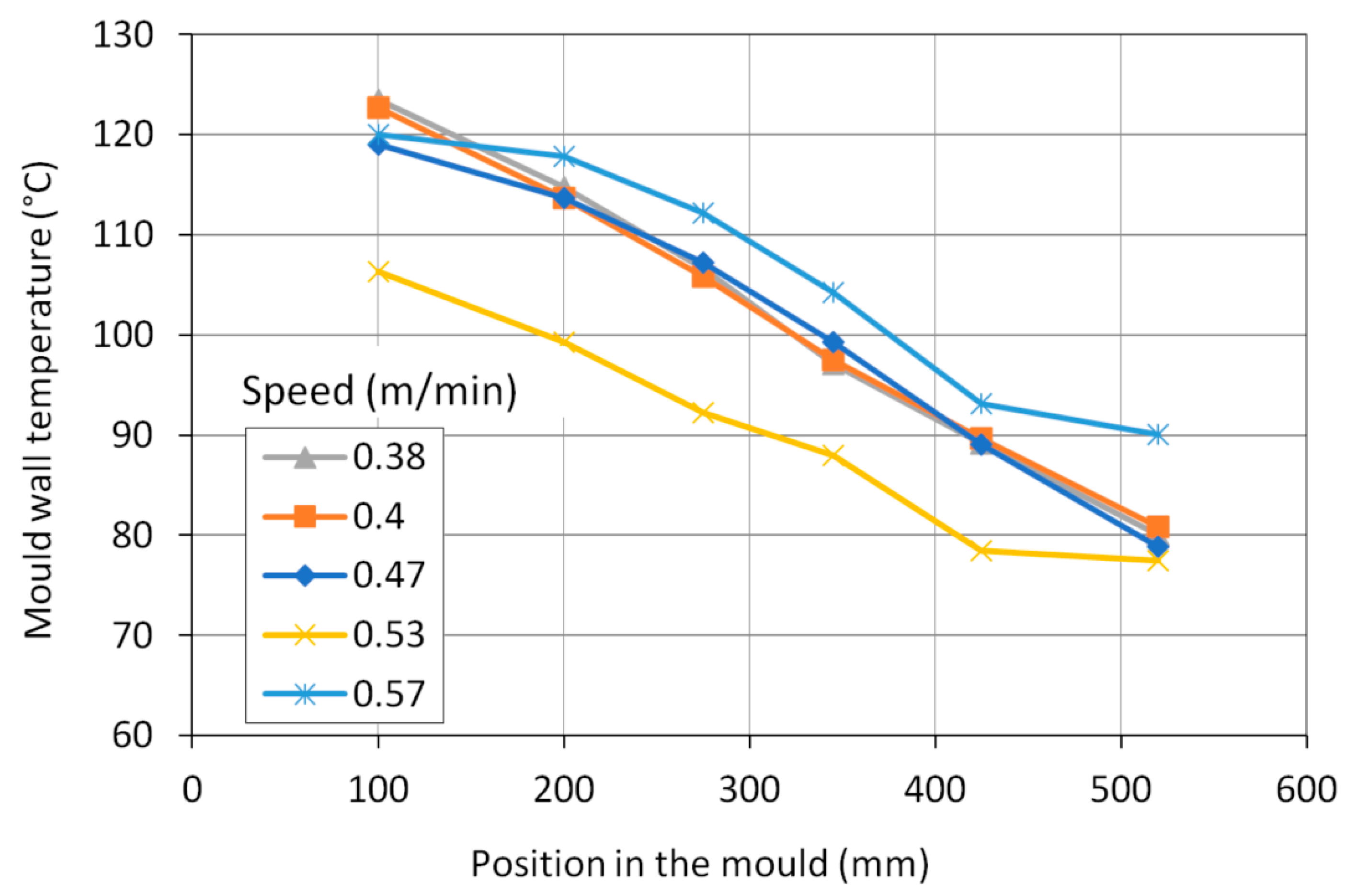
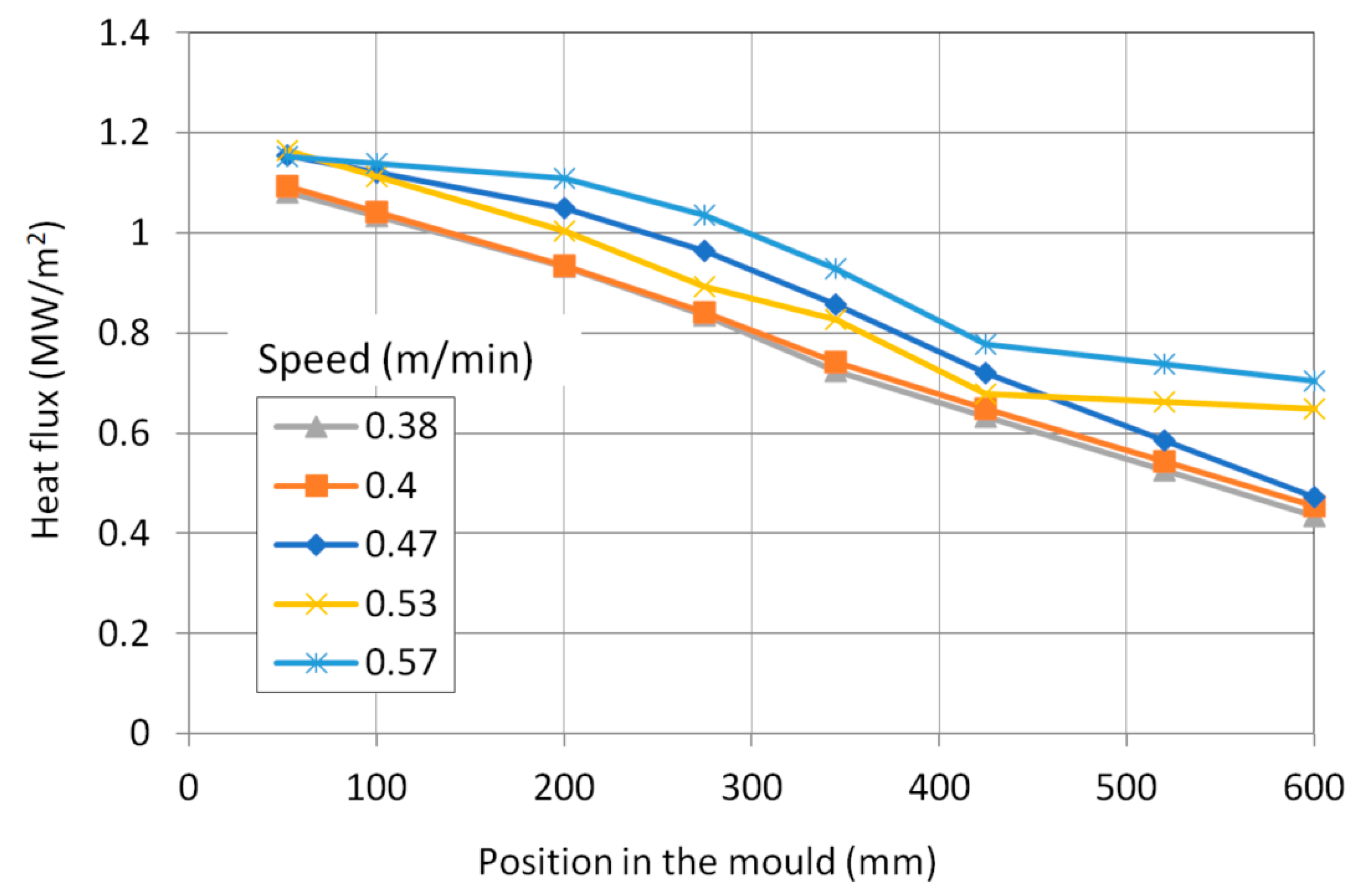
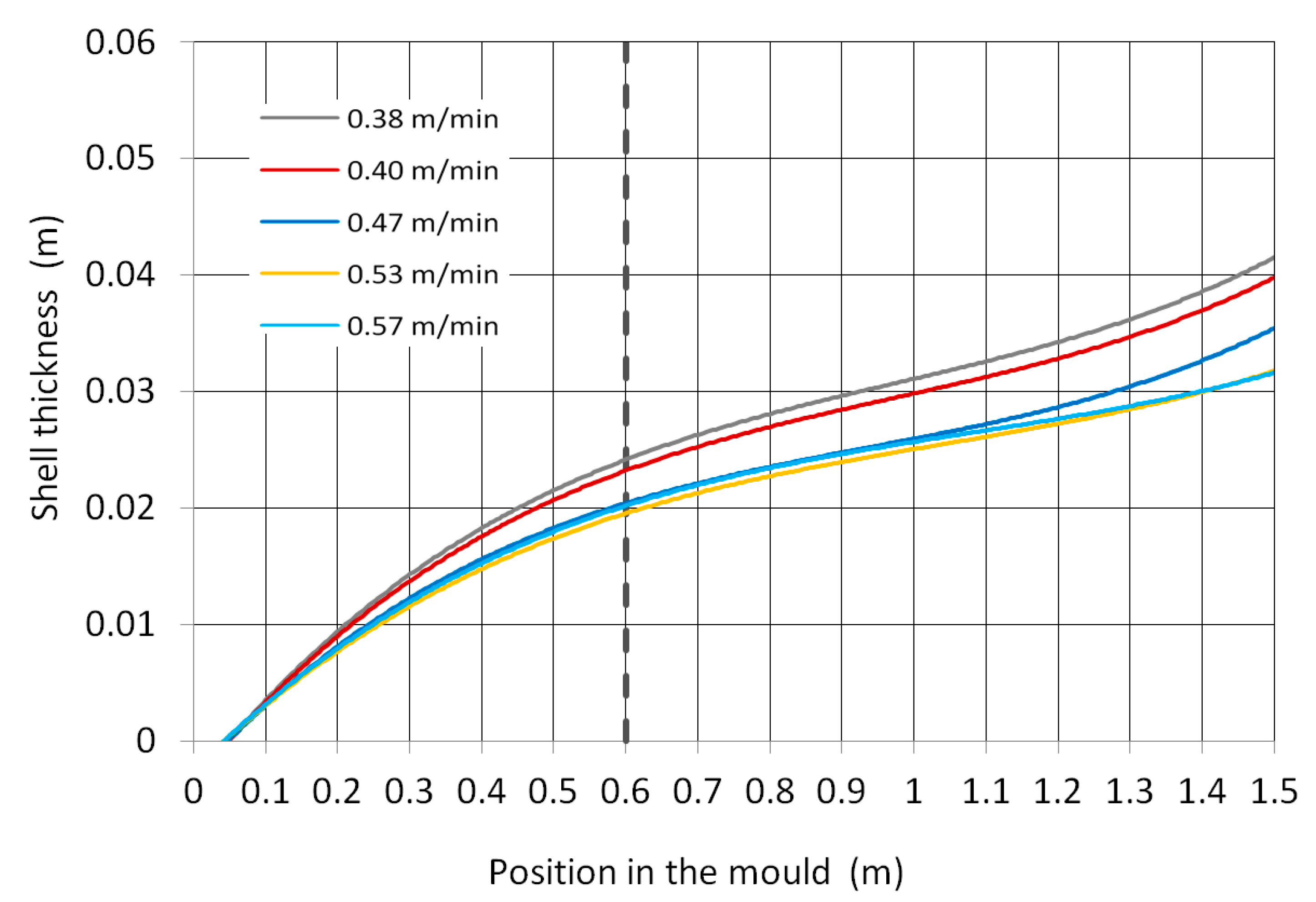

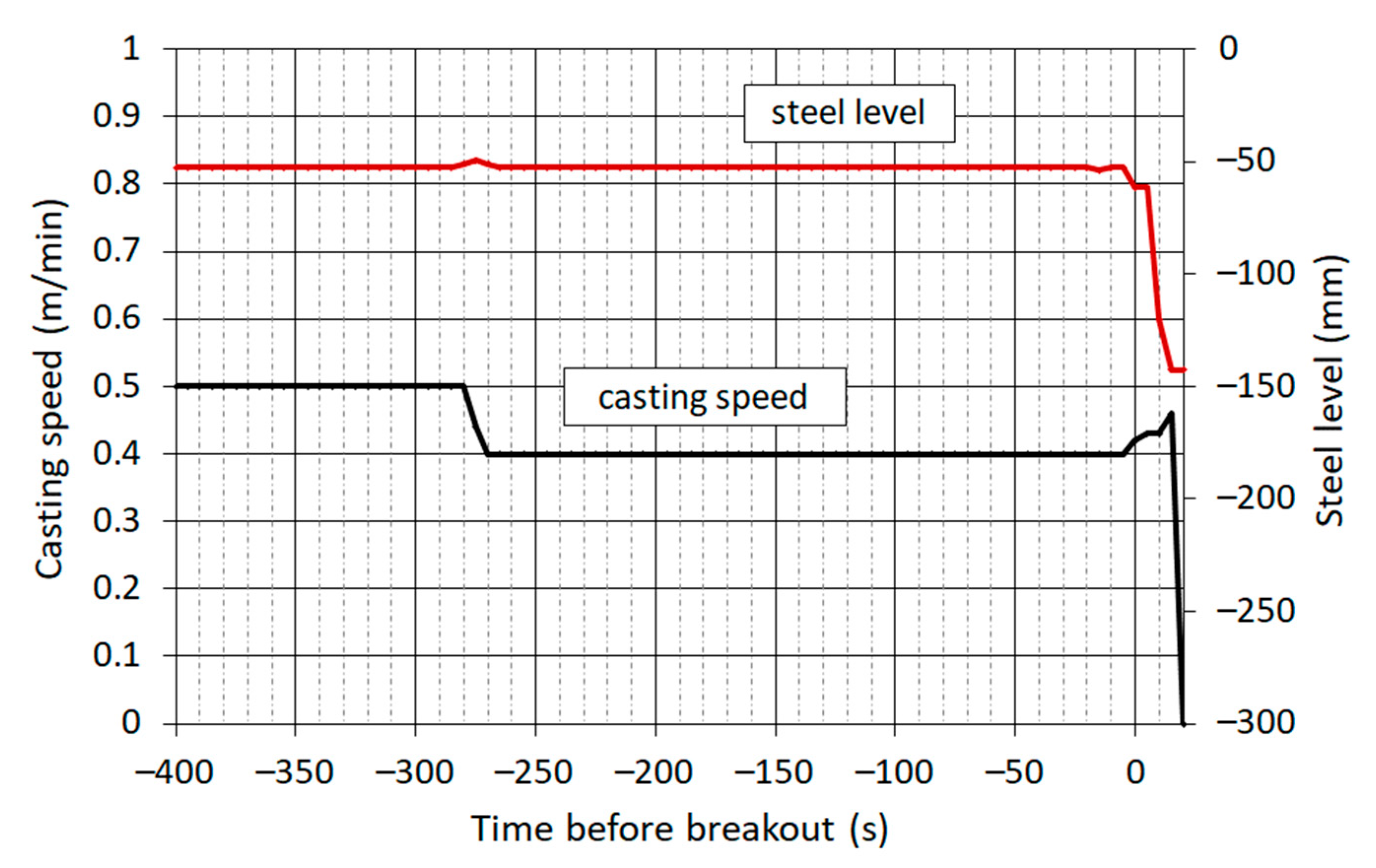


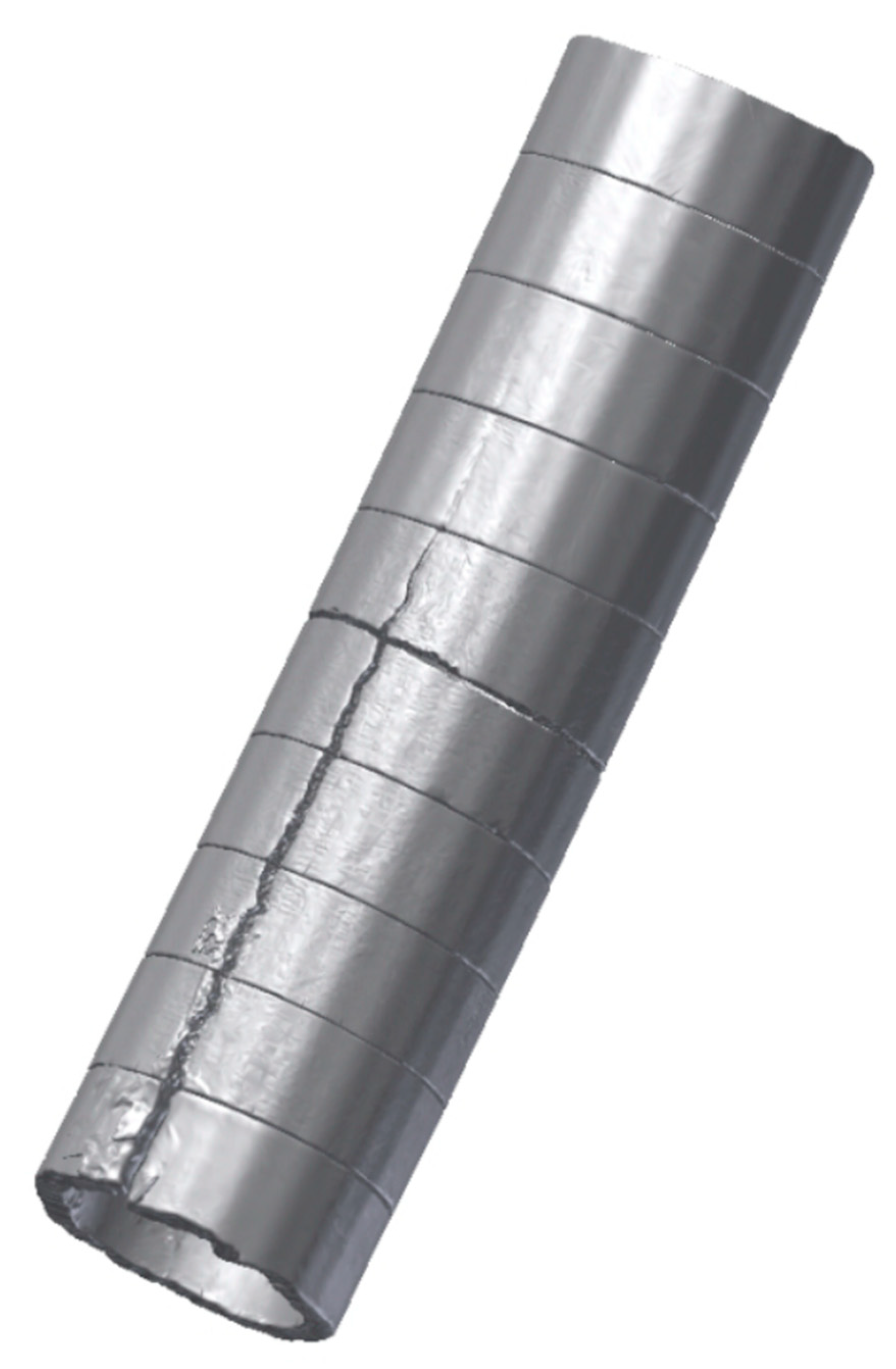

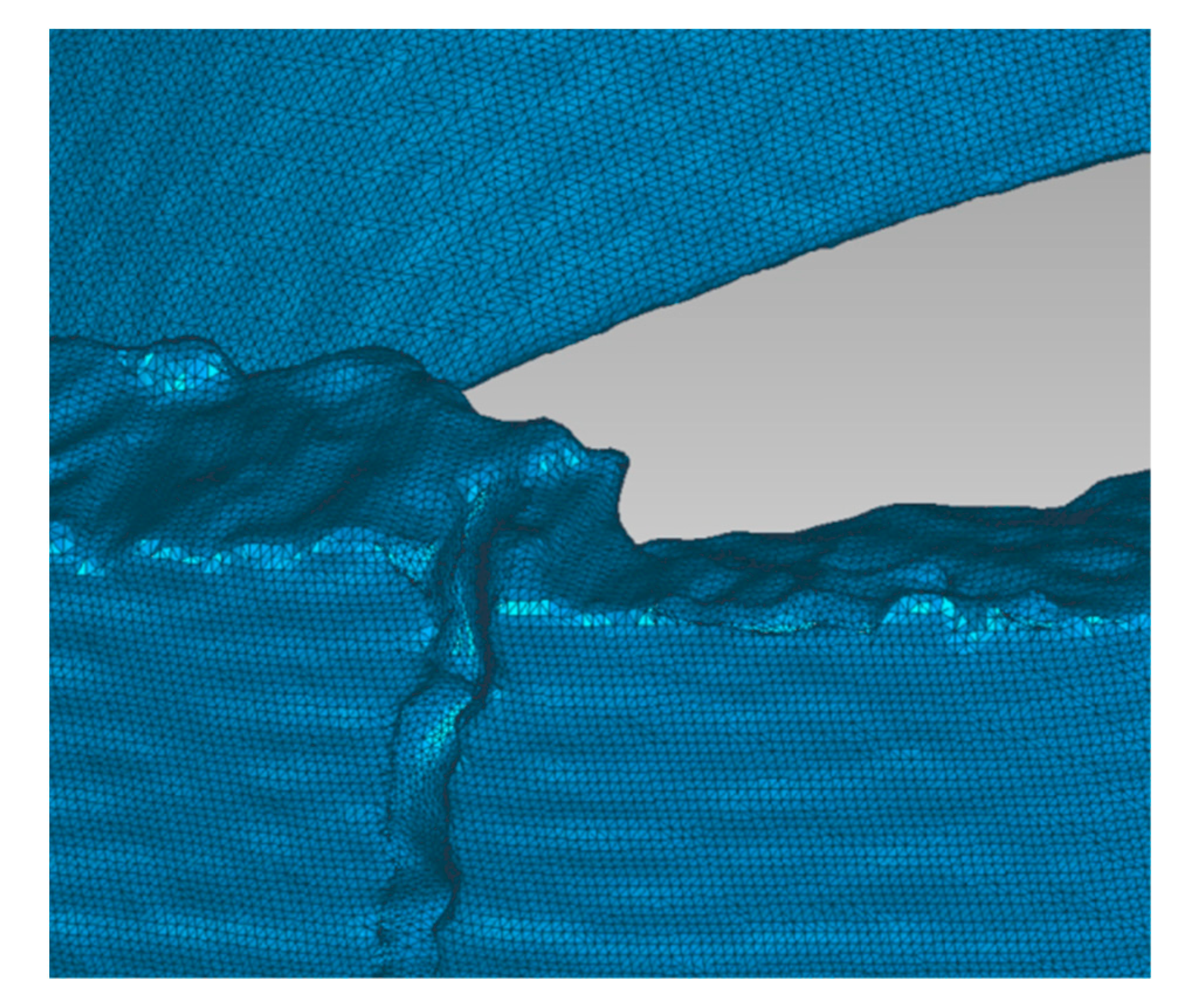

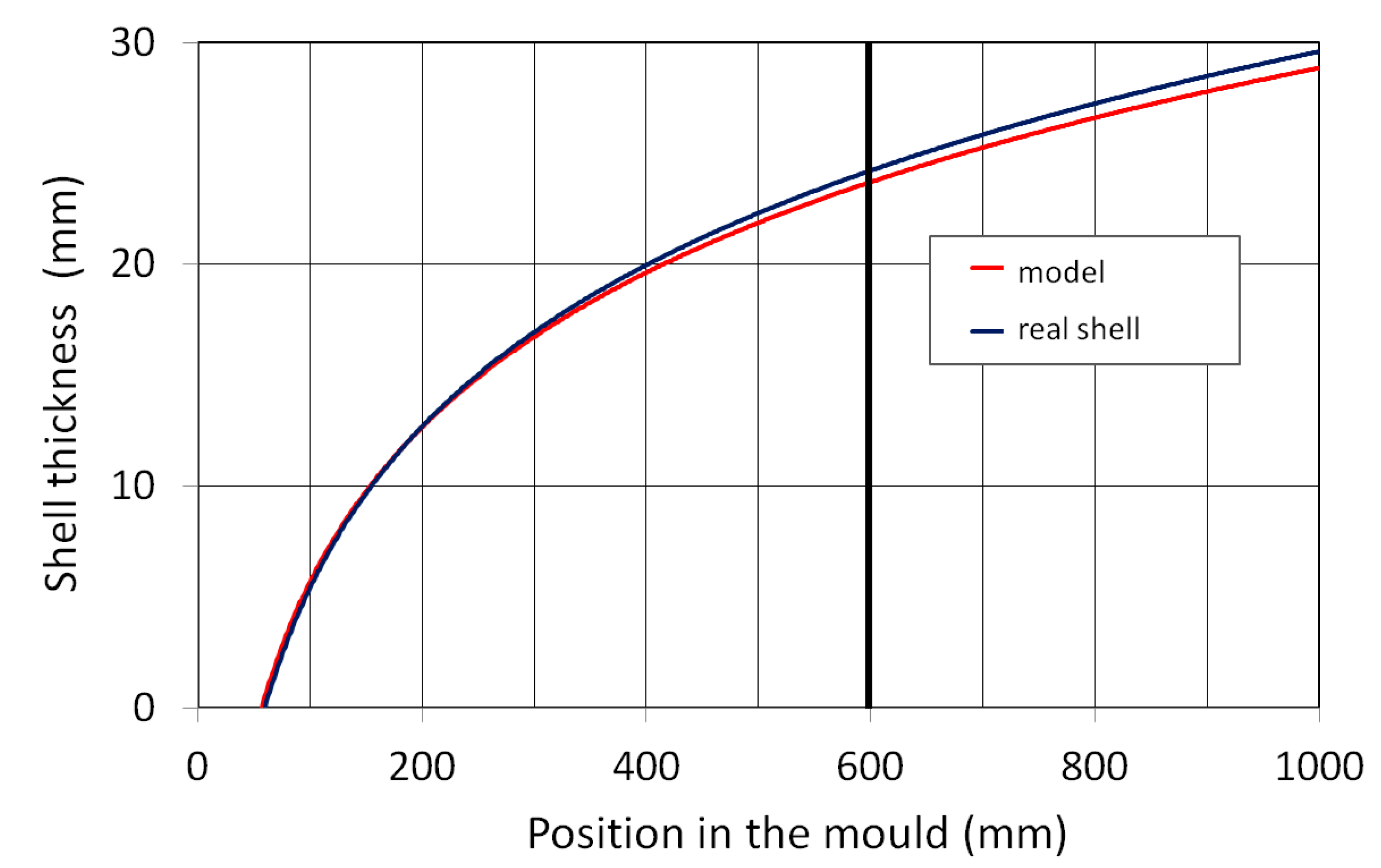
| C | Mn | Si | P | S |
|---|---|---|---|---|
| 0.168% | 1.360% | 0.390% | 0.026% | 0.024% |
Disclaimer/Publisher’s Note: The statements, opinions and data contained in all publications are solely those of the individual author(s) and contributor(s) and not of MDPI and/or the editor(s). MDPI and/or the editor(s) disclaim responsibility for any injury to people or property resulting from any ideas, methods, instructions or products referred to in the content. |
© 2023 by the authors. Licensee MDPI, Basel, Switzerland. This article is an open access article distributed under the terms and conditions of the Creative Commons Attribution (CC BY) license (https://creativecommons.org/licenses/by/4.0/).
Share and Cite
Velička, M.; Pyszko, R.; Machů, M.; Burda, J.; Kubín, T.; Ovčačíková, H.; Rigo, D. Research on Solid Shell Growth during Continuous Steel Casting. Materials 2023, 16, 5302. https://doi.org/10.3390/ma16155302
Velička M, Pyszko R, Machů M, Burda J, Kubín T, Ovčačíková H, Rigo D. Research on Solid Shell Growth during Continuous Steel Casting. Materials. 2023; 16(15):5302. https://doi.org/10.3390/ma16155302
Chicago/Turabian StyleVelička, Marek, René Pyszko, Mario Machů, Jiří Burda, Tomáš Kubín, Hana Ovčačíková, and David Rigo. 2023. "Research on Solid Shell Growth during Continuous Steel Casting" Materials 16, no. 15: 5302. https://doi.org/10.3390/ma16155302
APA StyleVelička, M., Pyszko, R., Machů, M., Burda, J., Kubín, T., Ovčačíková, H., & Rigo, D. (2023). Research on Solid Shell Growth during Continuous Steel Casting. Materials, 16(15), 5302. https://doi.org/10.3390/ma16155302







